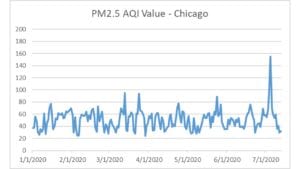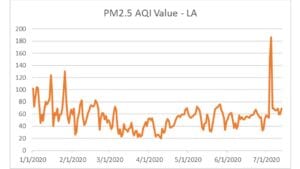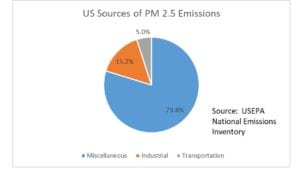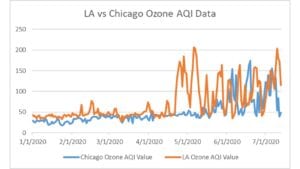A recent edition of the Sunday Chicago Tribune featured a story with the provocative headline “Chicago Air Dirtier in July than Notoriously Smoggy LA”, with the subhead “It didn’t improve during the lockdown, and more unhealthy days are coming." The story that followed was equal parts dishonest, foolish and lazy. But it provides this writer with a stellar example with which to demonstrate how deceptive environmental journalism is routinely fashioned by today’s mainstream media.
It’s no secret that mainstream media coverage of politics is unapologetically agenda-driven these days, but I’m not sure the public realizes how deeply that cancer has infected the MSM’s coverage of science and environmental topics. Let’s put "climate change" to the side for a moment. Politically-correct climate change coverage is symptom of the disease that metastasized decades ago when legacy journalists grew blind to the distinctions that separate healthy environmental protection from irrational ecological puritanism.
The dishonesty that infects MSM coverage of science and the environment is rarely apparent to the general public. Why should it be? Most of the deceptions involve technical points that appear too complex or obscure to pore over. Worse, the most skilled deceptions don’t involve outright lies, but skillful arrangement of only those facts that support the narrative. It’s not fake news so much as it is selective storytelling. The author of the doomsday yarn featured in the Sunday Trib, environmental writer Michael Hawthorne, is a master of this particular art.
In his piece, Hawthorne implies that Chicago’s air is now chronically unhealthy and is doomed to be so for a long time to come. He concludes that usual suspects are to blame for this sorry state of affairs: Donald Trump and climate change. And, of course, there is no shortage of supporting quotes from hand-picked “experts” and selective use of data to buttress the argument.
So, let’s start with that headline, is Chicago’s air quality now worse than the chronically smog-filled L.A. basin? To find out, we have to examine relevant data. To do that, we should start by understanding what the data is telling us.
A convenient way to look at air quality data is a metric the EPA has long used called the Air Quality Index, or AQI. The AQI is a comparison between actual readings by air quality monitors in the EPA system and the target concentrations that officially define what is clean air for a variety of air pollutants. These target concentrations are known as National Ambient Air Quality Standards, or NAAQS. An AQI score less than 100 means that the highest monitor readings that day did not exceed the applicable NAAQS. Such days are described as “good” or “moderate” depending on how far below the NAAQS the worst case monitoring data proved to be. An AQI score greater than 100 is described as some degree of “unhealthy.”
There are really only two air pollutants that routinely cause NAAQS exceedances in urban areas: fine particulate and ozone. Fine particulate, officially known as PM-2.5 and for some reason known only to Hawthorne and God as “soot,” consists of very, very small airborne particles about 1/40th the diameter of a human hair. Ozone, sometimes called smog, is produced from an interaction between two air pollutants. The first is oxides of nitrogen, or NOx, that is generated by forms of combustion, be it industrial boilers, your car’s engine, a forest fire, etc. The second is Volatile Organic Compounds, or VOC, which describes organic vapors of all kinds, from gasoline fumes, to paint thinners to the solvents used in nail polish. When these two pollutants have an opportunity to interact and a relatively hot and windless day provides the energy and environment for the right reactions to occur, ozone forms. Ozone in the upper stratosphere is a good thing, protecting us from ultraviolet light. This sort of ozone, much of which stays low in the troposphere where it can be inhaled is not desirable.
It should be noted at this point that the reason ozone and fine particulate are the most problematic pollutants in urban areas is not because emissions related to either have increased over the decades. The opposite is true: emission rates of ozone precursors and fine particulate have steadily and dramatically dropped in the United States since the Clean Air Act was first passed in 1970. It’s the definition of clean air that has changed. Administrations of both parties have steadily reduced NAAQS for these pollutants again and again, effectively moving the goal-posts to points that make compliance a distance speck on the horizon.
Now that you have earned your official air quality ranger merit badge, we can dive into Hawthorne’s claims. Let’s start with fine particulate. Here is a plot of worst case fine particulate PM-2.5 data for the greater Chicagoland metropolitan area for 2020, through July 13:

And here’s the Los Angeles basin for the same time period:

The LA monitors pop the limit seven times in the selected time period, while Chicago monitors do so only twice. And what might be the cause of that big peak that makes for the two days in July that both LA and Chicago monitors showed exceedances? The dates of the exceedances might provide a clue: July 4 and July 5. In his story, Hawthorne observes that “Independence Day celebrations added to the (air quality) problem”. A more realistic appraisal would be that Independence Day celebrations were the problem.
It’s also important to note that neither industry nor transportation sources contribute much to PM-2.5 pollution any longer. According to EPA data assembled during the Obama administration, about 80 percent of PM-2.5 emissions are generated by “miscellaneous” sources like natural activity, forest fires, agriculture, use of consumer products, etc.

This brings us to ozone. While it is true that June and July have been warmer on the average than mean temperatures in Chicago over the last twenty years, temperatures have not been outside of normal bounds. And though Chicago has seen a jump in ozone concentrations, there’s really no comparison to L.A. area ozone concentrations:

Through July 13, the Chicagoland area logged 16 “unhealthy” days based on ozone AQI. The L.A. Basin had 46 such days in the same time period, 6 of which exceeded the single worst ozone AQI day recorded in Chicago in 2020.
One question should remain in a genuinely curious journalist’s mind: even if Chicago’s air quality isn’t worse than Los Angeles’ – which it clearly is not – there has been a blip in ozone concentrations in the Chicagoland area. If that’s not the result of climate change or the president MSM journalists are sworn to hate, what is the cause? To quote Bob Dylan: the answer my friends is blowing in the wind.
We learned earlier that ozone forms when NOx, VOC and sunlight interact on relatively hot, windless days. In most places, the sum of the complex chemical reactions that produce ozone can be thought of as NOx playing the role of the “ore” than yields ozone, while VOC acts as the “pick” that “mines” the ore. In most places. Not in Chicago. In Chicago the prevailing winds and the location of Lake Michigan on the normally downwind side of local weather patterns can change this equation substantially. In many circumstances NOx emissions don’t matter all that much and in some of those they are even beneficial, reducing rather than increasing ozone formation in the Chicagoland air-shed. In recognition of this unique atmospheric chemistry, the USEPA issued a “NOx waiver” to Illinois back in the '90s that allowed the Agency to ignore NOx emissions as they related to ozone formation in the Chicagoland metropolitan area.
The waiver has since been revoked, but the science remains unchanged. Once the lockdown in Illinois began, monitoring data shows that ambient concentrations of NO2 (the portion of NOx that EPA monitors) dropped by about two-thirds compared to seasonal norms, as would be expected with the corresponding drop in traffic and industrial activity. The evidence thus strongly suggests that neither climate change nor the Trump administration is responsible for the odd spike in Chicago area ozone, but rather the odd meteorology of the area itself. Don’t expect Michael Hawthorne or the Chicago Tribune to consider that possibility however. For them, it’s all about the narrative or it’s about nothing at all.
Article tags: air quality, AQI, Chicago, Chicago Tribune, Environment, environmentalism, global warming, Green Movement, Michael Hawthorne, NAAQS, Virtue Signalling
[…] Rich Trzupek justly points to the “distinctions that separate healthy environmental protection from irrational ecological puritanism.” The confusion between environment and climate, whether ignorant or deliberate, is but another arrow in the Warmist quiver. […]
[…] Rich Trzupek justly points to the “distinctions that separate healthy environmental protection from irrational ecological puritanism.” The confusion between environment and climate, whether ignorant or deliberate, is but another arrow in the Warmist quiver. […]
[…] Read more at The Pipeline […]
[…] Read more at The Pipeline […]